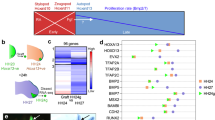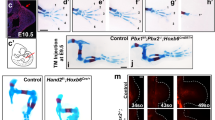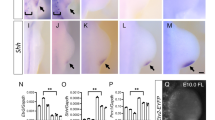Abstract
Vertebrate limbs grow out from the flanks of embryos, with their main axis extending proximodistally from the trunk. Distinct limb domains, each with specific traits, are generated in a proximal-to-distal sequence during development1. Diffusible factors expressed from signalling centres promote the outgrowth of limbs and specify their dorsoventral and anteroposterior axes2,3,4. However, the molecular mechanism by which limb cells acquire their proximodistal (P–D) identity is unknown1. Here we describe the role of the homeobox genes Meis1/2 and Pbx1 in the development of mouse, chicken and Drosophila limbs. We find that Meis1/2 expression is restricted to a proximal domain, coincident with the previously reported domain in which Pbx1 is localized to the nucleus5, and resembling the distribution of the Drosophila homologues homothorax (hth)5,6 and extradenticle (exd)7; that Meis1 regulates Pbx1 activity by promoting nuclear import of the Pbx1 protein; and that ectopic expression of Meis1 in chicken and hth in Drosophila disrupts distal limb development and induces distal-to-proximal transformations. We suggest that restriction of Meis1/Hth to proximal regions of the vertebrate and insect limb is essential to specify cell fates and differentiation patterns along the P–D axis of the limb.
This is a preview of subscription content, access via your institution
Access options
Subscribe to this journal
Receive 51 print issues and online access
$199.00 per year
only $3.90 per issue
Buy this article
- Purchase on Springer Link
- Instant access to full article PDF
Prices may be subject to local taxes which are calculated during checkout





Similar content being viewed by others
References
Johnson,R. L. & Tabin,C. J. Molecular models for vertebrate limb development. Cell 90, 979–990 (1997).
Niswander,L., Jeffrey,S., Martin,G. R. & Tickle,C. A positive feedback loop coordinates growth and patterning in the vertebrate limb. Nature 371, 609–612 (1994).
Laufer,E., Nelson,C. E., Johnson,R. L., Morgan,B. A. & Tabin,C. Sonic hedgehog and Fgf-4 act through a signaling cascade and feedback loop to integrate growth and patterning of the developing limb bud. Cell 79, 993–1003 (1994).
Parr,B. A. & McMahon,A. P. Dorsalizing signal Wnt-7a required for normal polarity of D–V and A–P axes of mouse limb. Nature 374, 350–353 (1995).
González-Crespo,S. et al. Antagonism between extradenticle fucntion and Hedgehog signalling in the developing limb. Nature 394, 196–200 (1998).
Abu-Shaar,M. & Mann,R. S. Generation of multiple antagonistic domains along the proximodistal axis during Drosophila leg development. Development 125, 3821–3830 (1998).
González-Crespo,S. & Morata,G. Genetic evidence for the subdivision of the arthropod limb into cosopodite and telopodite. Development 122, 3921–3928 (1996).
Summerbell,D., Lewis,J. & Wolpert,L. Positional information in chick limb morphogenesis. Nature 224, 492–496 (1973).
Moskow,J. J., Bullrich,F., Huebner,K., Daar,I. O. & Buchberg,A. M. Meis1, a PBX1-related homeobox gene involved in myeloid leukemia in BXH-2 mice. Mol. Cell. Biol. 15, 5434–5443 (1995).
Nakamura,T., Jenkins,N. A. & Copeland,N. G. Identification of a new family of Pbx-related homeobox genes. Oncogene 13, 2235–2242 (1996).
Cecconi,F., Proetzel,G., Alvarez-Bolado,G., Jay,D. & Gruss,P. Expression of Meis2, a Knotted-related murine homeobox gene, indicates a role in the differentiation of the forebrain and the somitic mesoderm. Dev. Dyn. 210, 184–190 (1997).
Oulad-Abdelghani,M. et al. Meis2, a novel mouse Pbx-related homeobox gene induced by retinoic acid during differentiation of P19 embryonal carcinoma cells. Dev. Dyn. 210, 173–183 (1997).
Berthelsen,J., Kilstrup-Nielsen,C., Blasi,F., Mavilio,F. & Zappavigna,V. The subcellular localization of PBX1 and EXD proteins depends on nuclear import and export signals and is modulated by association with PREP1 and HTH. Genes Dev. 13, 946–953 (1999).
Abu-Shaar,M., Ryoo,H. D. & Mann,R. S. Control of the nuclear localization of extradenticle by competing nuclear import and export signals. Genes Dev. 13, 935–945 (1999).
Pai,C. Y. et al. The Homothorax homeoprotein activates the nuclear localization of another homeoprotein, extradenticle, and suppresses eye development in Drosophila. Genes Dev. 12, 435–446 (1998).
Rieckhof,G. E., Casares,F., Ryoo,H. D., Abu-Shaar,M. & Mann,R. S. Nuclear translocation of extradenticle requires homothorax, which encodes an extradenticle-related homeodomain protein. Cell 91, 171–183 (1997).
Kamps,M. P., Murre,C., Sun,X. & Baltimore,D. A new homeobox gene contributes the DNA binding domain of the t(1;19) translocation protein in pre-B ALL. Cell 60, 547–555 (1990).
Nourse,J. et al. Chromosomal translocation t(1;19) results in synthesis of a homeobox fusion mRNA that codes for a potential chimeric transcription factor. Cell 60, 535–545 (1990).
Rowe,D. A. & Fallon,J. F. The proximodistal determination of skeletal parts in the developing chick leg. J. Embryol. Exp. Morphol. 68, 1–7 (1982).
Nelson,C. E. et al. Analysis of Hox gene expression in the chick limb bud. Development 122, 1449–1466 (1996).
Zakany,J. & Duboule,D. Hox genes in digit development and evolution. Cell. Tissue Res. 296, 19–25 (1999).
Morgan,B. A., Izpisúa-Belmonte,J. C., Duboule,D. & Tabin,C. J. Targeted misexpression of Hox-4.6 in the avian limb bud causes apparent homeotic transformations. Nature 358, 236–239 (1992).
Capdevila,J., Tsukui,T., Rodríguez-Esteban,C., Zappavigna,V. & Izpisúa-Belmonte,J. C. Regulatory interactions between the proximal determinant Meis2 and distal antagonism of BMP by Gremlin Control Vertebrate limb outgrowth. Mol. Cell (in the press).
Wu,J. & Cohen,S. M. Proximodistal axis formation in the Drosophila leg: subdivision into proximal and distal domains by Homothorax and Distal-less. Development 126, 109–117 (1999).
Brand,A. H. & Perrimon,N. Targeted gene expression as a means of altering cell fates and generating dominant phenotypes. Development 118, 401–415 (1993).
Goto,S. & Hayashi,S. Proximal to distal cell communication in the Drosophila leg provides a basis for an intercalary mechanism of limb patterning. Development 126, 3407–3413 (1999).
Shubin,N., Tabin,C. & Carroll,S. Fossils, genes and the evolution of animal limbs. Nature 388, 639–648 (1997).
Logan,M. & Tabin,C. Targeted gene misexpression in chick limb buds using avian replication-competent retroviruses. Methods 14, 407–420 (1998).
Wilkinson,D. G. & Nieto,M. A. Detection of messenger RNA by in situ hybridization to tissue sections and whole mount. Methods Enzymol. 225, 361–373 (1993).
Calleja,M., Moreno,E., Pelaz,S. & Morata,G. Visualization of gene expression in living adult Drosophila. Science 274, 252–255 (1996).
Celis,J. F. & Bray,S. Feed back mechanisms affecting Notch activation at the dorsoventral boundary in the Drosophila wing. Development 124, 3241–3251 (1997).
Acknowledgements
We thank P. Bovolenta and Á. Nieto for advice and help during the development of this project; Á. Nieto, D. R. Jones and C. Mark for critical reading of the manuscript; J. C. Izpisúa-Belmonte for unpublished results; and N. Copeland, J. C. Izpisúa-Belmonte, R. S. Mann and C. Tabin for probes. N.M. is a recipient of an ETH-CSIC collaborative fellowship and an EU Marie Curie predoctoral fellowship. N.A. and G.M. are supported by grants from the Spanish Dirección General de Investigación Cientifica y Técnica and Human Frontiers Program. The Department of Immunology and Oncology was founded and is supported by the Spanish Research Council (CSIC) and Pharmacia & Upjohn.
Author information
Authors and Affiliations
Corresponding author
Rights and permissions
About this article
Cite this article
Mercader, N., Leonardo, E., Azpiazu, N. et al. Conserved regulation of proximodistal limb axis development by Meis1/Hth. Nature 402, 425–429 (1999). https://doi.org/10.1038/46580
Received:
Accepted:
Issue Date:
DOI: https://doi.org/10.1038/46580
This article is cited by
-
Fgf signalling triggers an intrinsic mesodermal timer that determines the duration of limb patterning
Nature Communications (2023)
-
Co-option of the limb patterning program in cephalopod eye development
BMC Biology (2022)
-
Tig1 regulates proximo-distal identity during salamander limb regeneration
Nature Communications (2022)
-
Control of mouse limb initiation and antero-posterior patterning by Meis transcription factors
Nature Communications (2021)
-
Hoxd13/Bmp2-mediated mechanism involved in zebrafish finfold design
Scientific Reports (2021)
Comments
By submitting a comment you agree to abide by our Terms and Community Guidelines. If you find something abusive or that does not comply with our terms or guidelines please flag it as inappropriate.



